How to write cold emails with ChatGPT

A few years ago, artificial intelligence was just a buzzword for techies. But today it has become a hot topic for almost everyone – largely thanks to ChatGPT.
So what’s the big problem with ChatGPT?
ChatGPT is a natural language model that can generate human-like text based on prompts you enter. It’s like having a virtual writing companion who can help you write blog posts, SaaS product reviews, novels, poems, etc.
And cold emails?
Cold emails often get a bad reputation for being pushy, generic, and spammy. Actually just 8.5% of outreach emails received an answer. Can ChatGPT help?
Yes, it can. This allows you to create personalized cold emails that generate responses.
The three tips described in this article will help you write cold emails with ChatGPT.
1. Provide detailed prompts specific to the customer personas
The thing with generative AI Models are that the content you receive can only be as good as your prompts. If you don’t make your prompt specific, you’ll likely end up with generic content that won’t produce meaningful results.
But why are prompts so important?
Prompts provide the context and information the AI needs to generate the desired output. So if you want a personalized cold email, you need to provide a prompt that is specifically tailored to your target customer personas. The prompt also needs to be detailed enough for the AI to understand your goals.
However, these are the questions you should ask when inserting ChatGPT prompts:
- Who is your target group?
- What are their pain points or challenges?
- How can your product or service meet these needs?
- What is the purpose of the email? Should you introduce your product or service, arrange a meeting or build a relationship?
Here is a detailed guide to writing cold emails with ChatGPT that takes these tips into account:
Write a cold email to the sales manager at A&B Superstores. Their challenges include strict inventory management in stores and irregular balance sheets, which have proven to be time-consuming and burdensome. Our solution is an automated inventory manager that streamlines the process. Keep characters within 120 words.
Check out this result:
While this email is a good start, it could be improved.
So let’s personalize the email and make it shorter. Here is the command prompt I used:
Can you shorten the email above and make it more personal too?
This is what I got:

The succinct email is almost ready, but can be improved with personalized email greetings, a conversational tone, and persuasive language.
See the command prompt I used…
Can you refine the tone of this email to make it more friendly and conversational? Please also add an unusual greeting.
…for ChatGPT to make the specified changes:

In the example above, ChatGPT refined the tone of the email and made it more friendly.
However, the email lacks a clear call to action. So let’s add one to encourage recipient engagement.
Let’s use this prompt:
Can you add a compelling CTA to the email?
And voila!
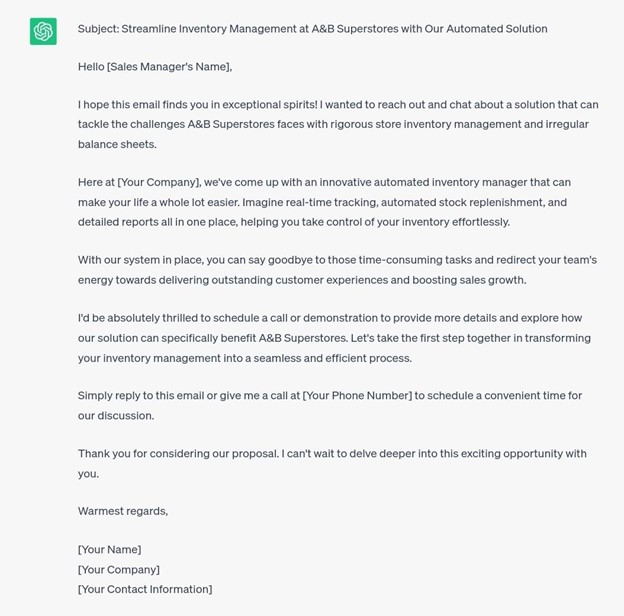
Now the email recipient can either reply to the email or call the sender to learn more about the inventory management tool.
Like this example, add as many specific prompts until you’re happy with your cold email.
2. Create a clear subject line
You personalized the email and added a call to action. What’s next?
Now you’ll make final tweaks to optimize the email for higher click-through rates and conversions. ThinkBlog Content optimizationbut for a cold email.
First, ask ChatGPT to write a catchy subject line.
The subject line is the gateway to your cold email. Your ideal customer is probably busy, so you want to generate interest quickly. Challenge ChatGPT to generate subject line ideas that are concise, compelling and entice recipients to open the email.
This is the prompt I used:
Can you name 10 catchy and concise subject lines for this email?
So ChatGPT gives me these email subject lines:

But these email subject lines seem overly promotional. So let’s ask ChatGPT to tone it down and personalize it to address the recipient’s pain point.
Remember that sales emails with personalized subject lines have a 35.6% open rate. So we can either mention the recipient’s name or reference a common interest or a recent event the recipient attended.
Take a look at my prompt:
Can you write 10 personalized and engaging email subject lines for this email? The recipient’s name is Jones and he recently attended the HubSpot sales event. Please keep to the maximum length of 60 characters.
This is what ChatGPT gave me:
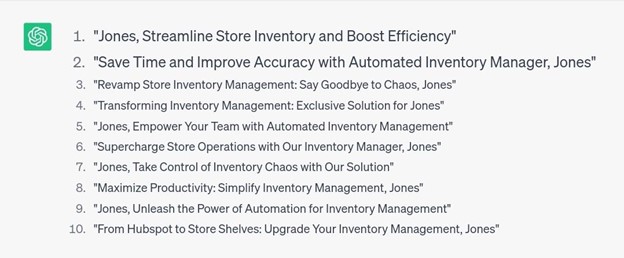
One more thing: There is no preheader text.
The preheader text gives an overview of what the email is about. We have to create one.
Make sure your subject lines and preheader text are optimally optimized for mobile viewing 81% of emails are read on mobile devices.
This is the prompt I used to get ChatGPT to generate preheader texts for the email subject lines it previously gave me:
Can you re-share the above subject lines and add their preheader texts? Please keep it concise, 60 characters maximum, and highly optimized for mobile viewing.
Here is the result:
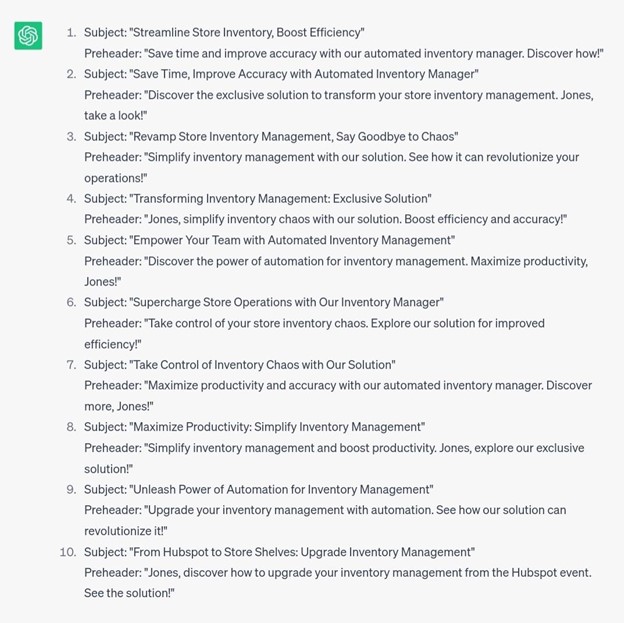
To make your cold emails even more effective, consider using some email copywriting tips when using ChatGPT.
Although ChatGPT-generated emails can be engaging and memorable, using these tips can further improve your messaging and improve email deliverability.
3. Create follow-up emails
As mentioned, cold emails have an average response rate of 8.5%. So chances are you won’t get a response on the first try. However, sending multiple follow-ups to one recipient can double your response rate. We recommend sending three follow-up emails to demonstrate your persistence and commitment to your recipient.
To create a successful follow-up email with ChatGPT, start by addressing your previous email. Then provide helpful insights to meet the recipient’s needs. You can also add value by sharing an informative article or useful tip, or linking them to a helpful resource.
To get ChatGPT to compose three follow-up emails to the previous email, I used this prompt:
Could you please share three follow-up emails to the same email to prospects who opened the email but did not respond? Reference the previous email and express genuine interest in addressing their needs by sharing an insightful resource. Also add a lead magnet.
Check out the results:
Follow-up email #1
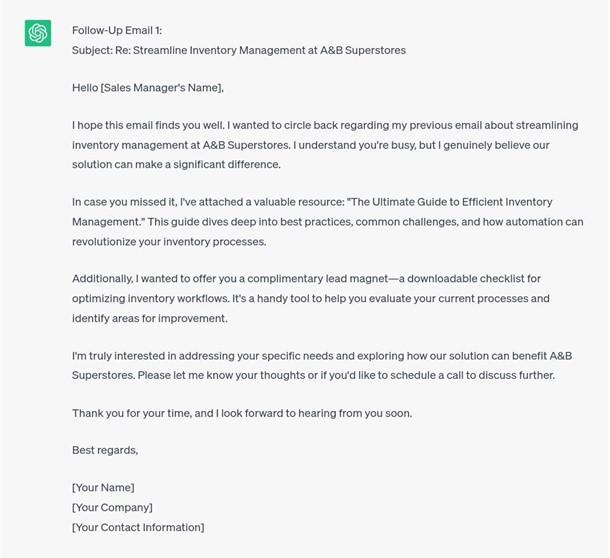
Follow-up email #2
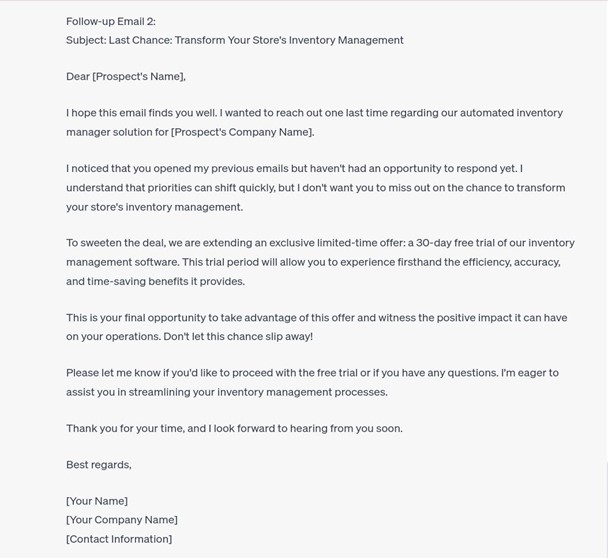
Follow-up email #3
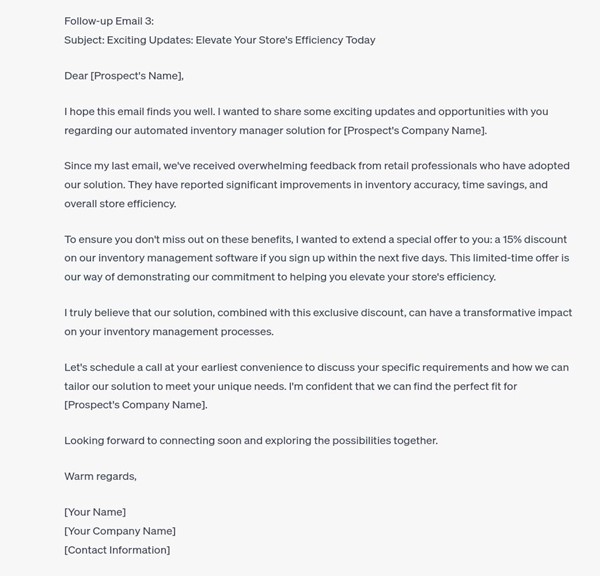
You can also use FOMO to create a sense of urgency and get them to act faster. However, make sure your tone is respectful and professional while still conveying your enthusiasm and passion for your product or service.
You can use this prompt:
Can you please share a fourth follow-up to these emails using FOMO to get them to take the action you want?
Here’s what I got from using this prompt:
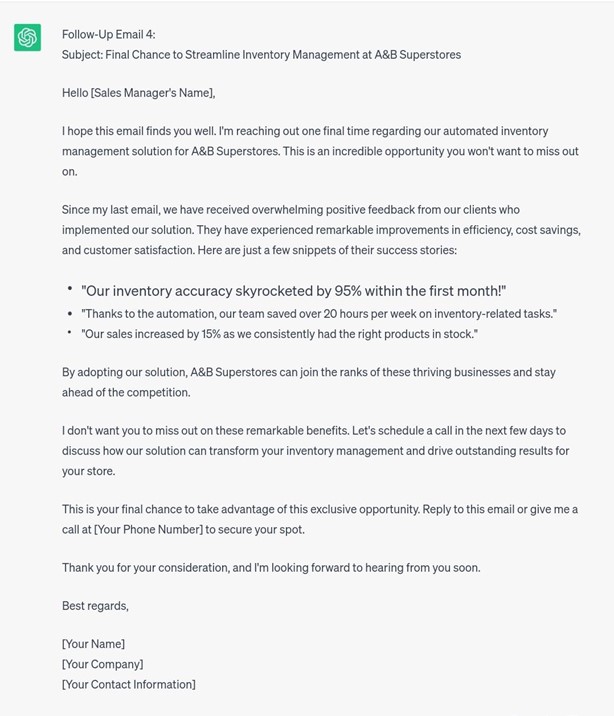
Finally, you can always use ChatGPT to optimize the language and tone of your follow-up emails to make them engaging and compelling without seeming pushy.
* * *
It has always been difficult to create the perfect cold calling email. A great cold calling email that worked last quarter could produce poor results today. So you need to stay innovative with your cold email strategy and develop creative content.
The good news is that large language models like ChatGPT make writing cold emails easier. You just need to know which prompts to use.
Generative AI gives you a good starting point. Just add a touch of humanity to your design and you’re good to go.
More resources on generative AI and cold email writing
How to Write Cold Emails to Millennials and Get a Response
Three creative cold email templates that get responses
The “Best” Use Cases for Unique Generative AI-Created Emails (Unfortunately!)
